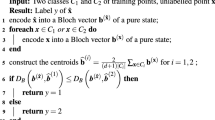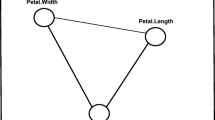Abstract
This work proposes a quantum representation for improvement of data discrimination power, transforming a non linearly separable problem into a linearly separable problem. This methodology proposed here can be naturally employed as data preprocessing for classification task. A classical real world system will be viewed as a composition of quantum systems, where any observable measurement process of the real world data are created from an expected value measure of a quantum system state. In this projection measure a quantum phase information is naturally lost, making the inverse mapping from the classical space into quantum space impossible. However, it is possible find an arbitrate quantum state that represents the same classical information originally measured. A genetic algorithm is employed for search this arbitrate quantum state, going back from classical world to quantum world representation. The genetic algorithm searches for a compatible quantum state with the real world data, where the lost quantum phase is adjusted with the constraints to minimize the classes’ variance and to maximize the distance between the classes’ centroids. Computational simulations shown that the proposed methodology was able to transform a non linearly separable problem in classical representation space into a linearly separable problem in the quantum representation space, demonstrating an enhancement of data discrimination power.






Similar content being viewed by others
Explore related subjects
Discover the latest articles, news and stories from top researchers in related subjects.References
Afzal AL, Asharaf S (2018) Deep multiple multilayer kernel learning in core vector machines. Exp Syst Appl 96:149–156. https://doi.org/10.1016/j.eswa.2017.11.058
Barani F, Mirhosseini M, Nezamabadi-pour H (2017) Application of binary quantum-inspired gravitational search algorithm in feature subset selection. Appl Intell 47(2):304–318. https://doi.org/10.1007/s10489-017-0894-3
Cano JR (2013) Analysis of data complexity measures for classification. Exp Syst Appl 40:4820–4831
Chen P, Jiao L, Liu F, Zhao J, Zhao Z, Liu S (2017) Semi-supervised double sparse graphs based discriminant analysis for dimensionality reduction. Pattern Recognit 61:361–378. https://doi.org/10.1016/j.patcog.2016.08.010
Cohen-Tannoudji C, Diu B, Laloe F (1977) Quantum mechanics. Wiley, Paris
Cover T, Hart P (1967) Nearest neighbor pattern classification. IEEE Trans Inf Theory 13(1):21–27. https://doi.org/10.1109/TIT.1967.1053964
Cover TM (1965) Geometrical and statistical properties of systems of linear inequalities with applications in pattern recognition. IEEE Trans Eletron Comput EC–14(3):326–334
de Andrade DC, Trabasso LG (2018) Elm based architecture for general purpose automatic weight and structure learning. Neurocomputing 275:804–817. https://doi.org/10.1016/j.neucom.2017.09.026
Debnath L, Mikusiński P (2005) Hilbert spaces with applications, 3rd edn. Elsevier Academic Press, Beijing
Duda RO, Hart PE, Stork DG (2000) Pattern classification, 2nd edn. Wiley, New York
Elizondo D (2006) The linear separability problem: some testing methods. IEEE Trans Neural Netw 17(2):330–344
Ferreira MR, de Carvalho FDA, Simões EC (2016) Kernel-based hard clustering methods with kernelization of the metric and automatic weighting of the variables. Pattern Recognit 51:310–321. https://doi.org/10.1016/j.patcog.2015.09.025
Ferreira TAE, Vasconcelos GC, Adeodato PJL (2008) A new intelligent system methodology for time series forecasting with artificial neural networks. Neural Process Lett 28(2):113–129. https://doi.org/10.1007/s11063-008-9085-x
Frank A, Asuncion A (2013) UCI machine learning repository. University of California, School of Information and Computer Science, Irvine, CA. http://archive.ics.uci.edu/ml. Accessed 2 July 2018
Gao Y, Gao F (2010) Edited adaboost by weighted knn. Neurocomputing 73(16):3079–3088. https://doi.org/10.1016/j.neucom.2010.06.024
García J, Crawford B, Soto R, Castro C, Paredes F (2018) A k-means binarization framework applied to multidimensional knapsack problem. Appl Intell 48(2):357–380. https://doi.org/10.1007/s10489-017-0972-6
Gupta U, Ranganathan N (2010) A game theoretic approach for simultaneous compaction and equipartitioning of spatial data sets. IEEE Trans Knowl Data Eng 22(4):465–478. https://doi.org/10.1109/TKDE.2009.110
Gyongyosi L (2017) Quantum imaging of high-dimensional Hilbert spaces with radon transform. Int J Circuit Theory Appl 45(7):1029–1046. https://doi.org/10.1002/cta.2332
Gyongyosi L, Imre S (2018) Unsupervised machine learning control of quantum gates in gate-model quantum computers. In: Frontiers in optics/laser science, Optical Society of America, FTh1B.3. https://doi.org/10.1364/FIO.2018.FTh1B.3, URL http://www.osapublishing.org/abstract.cfm?URI=FiO-2018-FTh1B.3
Gyongyosi L, Imre S, Nguyen HV (2018) A survey on quantum channel capacities. IEEE Commun Surv Tutor 20(2):1149–1205. https://doi.org/10.1109/COMST.2017.2786748
Haddar B, Khemakhem M, Rhimi H, Chabchoub H (2016) A quantum particle swarm optimization for the 0–1 generalized knapsack sharing problem. Nat Comput 15(1):153–164. https://doi.org/10.1007/s11047-014-9470-5
Hasanzadeh-Mofrad M, Rezvanian A (2018) Learning automata clustering. J Comput Sci 24:379–388. https://doi.org/10.1016/j.jocs.2017.09.008
Huang X, Ye Y, Guo H, Cai Y, Zhang H, Li Y (2014) DSKmeans: a new kmeans-type approach to discriminative subspace clustering. Knowl Based Syst 70:293–300
Huang Z, Zhou Z, He T (2013) Associative classification with knn. J Theor Appl Inf Technol 49(3):1013–1019
Imre S, Gyongyosi L (2012) Advanced quantum communications: an engineering approach. Wiley, Hoboken
Leung FHF, Lam HK, Ling SH, Tam PKS (2003) Tuning of the structure and parameters of a neural network using an improved genetic algorithm. IEEE Trans Neural Netw 14(1):79–88. https://doi.org/10.1109/TNN.2002.804317
Li J, Xu B, Yang Y, Wu H (2018) Quantum ant colony optimization algorithm for AGVS path planning based on bloch coordinates of pheromones. Nat Comput. https://doi.org/10.1007/s11047-018-9711-0
Li Y, Su L, Chen J, Yuan L (2017) Semi-supervised learning for question classification in CQA. Nat Comput 16(4):567–577. https://doi.org/10.1007/s11047-016-9554-5
Liu J, Wang H, Sun Y, Li L (2016) Adaptive Niche quantum-inspired immune clonal algorithm. Nat Comput 15(2):297–305. https://doi.org/10.1007/s11047-015-9495-4
Liu X, Liu Z, Wang G, Cai Z, Zhang H (2018a) Ensemble transfer learning algorithm. IEEE Access 6:2389–2396. https://doi.org/10.1109/ACCESS.2017.2782884
Liu YT, Pal NR, Marathe AR, Lin CT (2018b) Weighted fuzzy dempster-shafer framework for multimodal information integration. IEEE Trans Fuzzy Syst 26(1):338–352. https://doi.org/10.1109/TFUZZ.2017.2659764
Lv F, Yang G, Zhu W, Liu C (2017) Generative classification model for categorical data based on latent Gaussian process. Pattern Recognit Lett 92:56–61. https://doi.org/10.1016/j.patrec.2017.03.025
López J, Maldonado S (2018) Redefining nearest neighbor classification in high-dimensional settings. Pattern Recognit Lett 110:36–43. https://doi.org/10.1016/j.patrec.2018.03.023
Ma H, Gou J, Wang X, Ke J, Zeng S (2017) Sparse coefficient-based \({k}\)-nearest neighbor classification. IEEE Access 5:16618–16634. https://doi.org/10.1109/ACCESS.2017.2739807
Mehrkanoon S, Huang X, Suykens JA (2018) Indefinite kernel spectral learning. Pattern Recognit 78:144–153. https://doi.org/10.1016/j.patcog.2018.01.014
Nielsen MA, Chuang IL (2000) Quantum computation and quantum information, 1st edn. Cambridge University Press, New York
Panahi N, Shayesteh MG, Mihandoost S, Varghahan BZ (2011) Recognition of different datasets using PCA, LDA and various classifiers. In: Application of information and communication technologies (AICT), 5th international conference, Baku
Prabhu P, Anbazhagan N (2011) Improving the performance of k-means clustering for high dimensional data set. Int J Comput Sci Eng 3(6):2317–2322
Saez JA, Luengo J, Herrera F (2013) Predicting noise filtering efficacy with data complexity measures for nearest neighbor classification. Pattern Recognit 46:355–364
Sheikhpour R, Sarram MA, Gharaghani S, Chahooki MAZ (2017) A survey on semi-supervised feature selection methods. Pattern Recognit 64:141–158. https://doi.org/10.1016/j.patcog.2016.11.003
Vapnik VN (1998) Statistical learning theory. Wiley, New York
Wu X, Zhu X (2008) Mining with noise knowledge: error-aware data mining. IEEE Trans Syst Man Cybern A Syst Hum 38(4):917–932
Wu X, Kumar V, Quinlan J, Ghosh J, Yang Q, Motoda H, McLachlan G, Ng A, Liu B, Yu P, Zhou ZH, Steinbach M, Hand D, Steinberg D (2008) Top 10 algorithms in data mining. Knowl Inf Syst 14(1):1–37
Xu R II, Wunsch D (2005) Survey of clustering algorithms. IEEE Trans Neural Netw 16(3):645
Zhang C, Fang Z (2013) An improved k-means clustering algorithm. J Inf Comput Sci 10:193–199
Zhang C, Liu C, Zhang X, Almpanidis G (2017a) An up-to-date comparison of state-of-the-art classification algorithms. Exp Syst Appl 82:128–150. https://doi.org/10.1016/j.eswa.2017.04.003
Zhang Y, Wu J, Zhou C, Cai Z (2017b) Instance cloned extreme learning machine. Pattern Recognit 68:52–65. https://doi.org/10.1016/j.patcog.2017.02.036
Acknowledgements
To the Science and Technology Support Foundation of Pernambuco (FACEPE) Brazil, Brazilian National Council for Scientific and Technological Development (CNPq) and Coordenação de Aperfeiçoamento de Pessoal de Nível Superior—Brasil (CAPES)—Finance Code 001 by financial support for the development of this research.
Author information
Authors and Affiliations
Corresponding author
Additional information
Publisher's Note
Springer Nature remains neutral with regard to jurisdictional claims in published maps and institutional affiliations.
Rights and permissions
About this article
Cite this article
Sousa, R.B.d., Pereira, E.J.S., Cipolletti, M.P. et al. A proposal of quantum data representation to improve the discrimination power. Nat Comput 19, 577–591 (2020). https://doi.org/10.1007/s11047-019-09734-w
Published:
Issue Date:
DOI: https://doi.org/10.1007/s11047-019-09734-w




